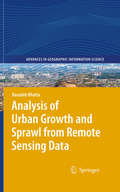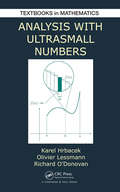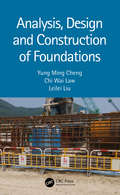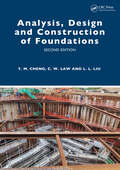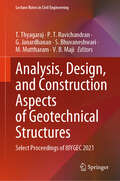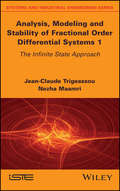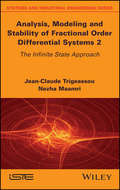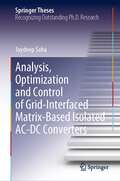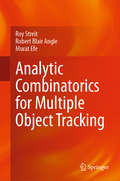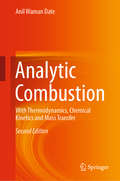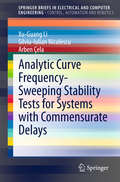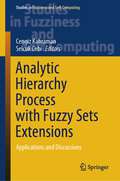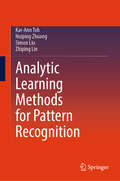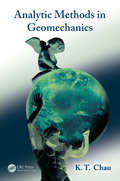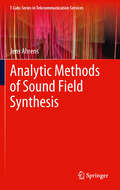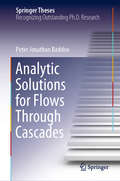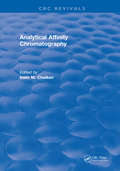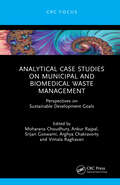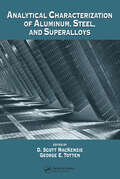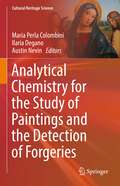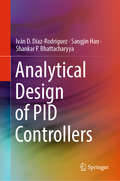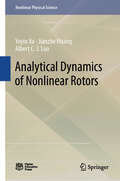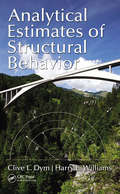- Table View
- List View
Analysis of Urban Growth and Sprawl from Remote Sensing Data (Advances in Geographic Information Science)
by Basudeb BhattaThis book provides a comprehensive discussion on urban growth and sprawl, and how they can be analyzed using remote sensing imageries. It compiles views of numerous researchers that help in understanding the urban growth and sprawl; their patterns, process, causes, consequences, and countermeasures; how remote sensing data and geographic information system techniques can be used in mapping, monitoring, measuring, analyzing, and simulating the urban growth and sprawl and what are the merits and demerits of available methods and models. This book will be of value for the scientists and researchers engaged in urban geographic research, especially using remote sensing imageries. This book will serve as a rigours literature review for them. Post graduate students of urban geography or urban/regional planning may refer this book as additional studies. This book may help the academicians for preparing lecture notes and delivering lectures. Industry professionals may also be benefited from the discussed methods and models along with numerous citations.
Analysis with Ultrasmall Numbers (Textbooks in Mathematics)
by Karel Hrbacek Olivier Lessmann Richard O'DonovanAnalysis with Ultrasmall Numbers presents an intuitive treatment of mathematics using ultrasmall numbers. With this modern approach to infinitesimals, proofs become simpler and more focused on the combinatorial heart of arguments, unlike traditional treatments that use epsilon-delta methods. Students can fully prove fundamental results, such as the
Analysis, Design and Construction of Foundations
by Y M Cheng Chi Wai Law Lei Lei LiuAnalysis, Design and Construction of Foundations outlines methods for analysis and design of the construction of shallow and deep foundations with particular reference to case studies in Hong Kong and China, as well as a discussion of the methods used in other countries. It introduces the main approaches used by geotechnical and structural engineers, and the precautions required for planning, design and construction of foundation structures. Some computational methods and computer programmes are reviewed to provide tools for performing a more realistic analysis of foundation systems. The authors examine in depth the methods used for constructing shallow foundations, deep foundations, excavation and lateral support systems, slope stability analysis and construction, and ground monitoring for proper site management. Some new and innovative foundation construction methods are also introduced. It is illustrated with case studies of failures and defects from actual construction projects. Some advanced and modern theories are also covered in this book. This book is more targeted towards the understanding of the basic behavior and the actual construction of many geotechnical works, and this book is not dedicated to any design code or specification, though Euro codes and Hong Kong code are also used in this book for illustration. It is ideal for consulting geotechnical engineers, undergraduate and postgraduate students.
Analysis, Design and Construction of Foundations
by Chi Wai Law Leilei Liu Yung Ming ChengAnalysis, Design and Construction of Foundations covers the key concepts in the analysis and design of foundation systems, balancing theory with engineering practice.The book examines in depth the methods used for the analysis, design and construction of shallow foundations, deep foundations, excavation and lateral support systems, slope stability and stabilization and ground monitoring for proper site management. Some new and innovative foundation construction methods are also introduced. It is illustrated with case studies of failures and defects from actual construction projects.This second edition is extensively revised and developed to include a new chapter on numerical methods in geotechnical engineering, as well as a large number of new construction drawings, project photos and construction method statements from existing projects to give the book a stronger professional application and connection to engineering practice. It also covers some new advanced theoretical concepts not covered in other texts, making it useful in both the theoretical and practical aspects. It is ideal for senior undergraduates and graduate students, academics and consulting geotechnical engineers.
Analysis, Design, and Construction Aspects of Geotechnical Structures: Select Proceedings of 8IYGEC 2021 (Lecture Notes in Civil Engineering #421)
by V. B. Maji M. Muttharam T. Thyagaraj P. T. Ravichandran G. Janardhanan S. BhuvaneshwariThis book presents the select proceedings of the 8th Indian Young Geotechnical Engineers Conference (8IYGEC 2021) on the following conference themes: Foundation Engineering, Rock Engineering, Slope Stability and Landslides and Deep Excavation and Underground Structures. The book covers a wide range of topics on foundation engineering that include analysis and performance of piled raft foundations, uplift capacity of helical and micro piles, and behaviour of anchor plates. The topics on slope stability and landslides include early warning system for landslides, landslide mitigation and simulation, rainfall induced landslide analysis and slope stability assessment of highway embankments, backfills, concave slopes, coal mine overburden dump and shallow footing on slope. Further, the various aspects of deep excavation and underground structures including the performance predictive models and ground response due to excavations, buried drainage pipe leakage, and urban metro tunnel construction are covered in this book. This book can be a valuable reference for academicians and practicing engineers.
Analysis, Modeling and Stability of Fractional Order Differential Systems 1: The Infinite State Approach
by Jean-Claude Trigeassou Nezha MaamriThis book introduces an original fractional calculus methodology (‘the infinite state approach’) which is applied to the modeling of fractional order differential equations (FDEs) and systems (FDSs). Its modeling is based on the frequency distributed fractional integrator, while the resulting model corresponds to an integer order and infinite dimension state space representation. This original modeling allows the theoretical concepts of integer order systems to be generalized to fractional systems, with a particular emphasis on a convolution formulation.
Analysis, Modeling and Stability of Fractional Order Differential Systems 2: The Infinite State Approach
by Jean-Claude Trigeassou Nezha MaamriThis book introduces an original fractional calculus methodology ('the infinite state approach') which is applied to the modeling of fractional order differential equations (FDEs) and systems (FDSs). Its modeling is based on the frequency distributed fractional integrator, while the resulting model corresponds to an integer order and infinite dimension state space representation. This original modeling allows the theoretical concepts of integer order systems to be generalized to fractional systems, with a particular emphasis on a convolution formulation. With this approach, fundamental issues such as system state interpretation and system initialization – long considered to be major theoretical pitfalls – have been solved easily. Although originally introduced for numerical simulation and identification of FDEs, this approach also provides original solutions to many problems such as the initial conditions of fractional derivatives, the uniqueness of FDS transients, formulation of analytical transients, fractional differentiation of functions, state observation and control, definition of fractional energy, and Lyapunov stability analysis of linear and nonlinear fractional order systems. This second volume focuses on the initialization, observation and control of the distributed state, followed by stability analysis of fractional differential systems.
Analysis, Optimization and Control of Grid-Interfaced Matrix-Based Isolated AC-DC Converters (Springer Theses)
by Jaydeep SahaThis book presents novel contributions in the development of solid-state-transformer (SST) technology both for medium-voltage (MV) and low-voltage (LV) utility grid interfaces, which can potentially augment the grid modernization process in the evolving power system paradigm. For the MV interface, a single-stage AC-DC SST submodule topology has been proposed, and its modulation and soft-switching possibilities are analysed, experimentally validated and adequately benchmarked. A control scheme with power balance capability among submodules is developed for MV grid-connected single-stage AC-DC SST for smooth operation under inevitable parameter drift scenario, and experimental validation shows excellent performance under drastic load change conditions. A novel machine learning-aided multi-objective design optimization framework for grid-connected SST is developed and experimentally validated, which equips a power electronics design engineer with meagre computational resources to find out the most optimal SST design in a convenient time-frame. This book has also contributed towards the development of dual-active-bridge (DAB)-type and non-DAB-type LV grid-interfaced isolated AC-DC converters by providing solutions to specific topology and modulation-related shortcomings in these two types of topologies. A comprehensive comparison of the DAB and non-DAB-type LVAC-LVDC converters reveals the superiority of DAB-type conversion strategy.
Analysis, Retrieval and Delivery of Multimedia Content (Lecture Notes in Electrical Engineering #158)
by Andrea Cavallaro Pierangelo Migliorati Nicola Adami Riccardo LeonardiCovering some of the most cutting-edge research on the delivery and retrieval of interactive multimedia content, this volume of specially chosen contributions provides the most updated perspective on one of the hottest contemporary topics. The material represents extended versions of papers presented at the 11th International Workshop on Image Analysis for Multimedia Interactive Services, a vital international forum on this fast-moving field. Logically organized in discrete sections that approach the subject from its various angles, the content deals in turn with content analysis, motion and activity analysis, high-level descriptors and video retrieval, 3-D and multi-view, and multimedia delivery. The chapters cover the finest detail of emerging techniques such as the use of high-level audio information in improving scene segmentation and the use of subjective logic for forensic visual surveillance. On content delivery, the book examines both images and video, focusing on key subjects including an efficient pre-fetching strategy for JPEG 2000 image sequences. Further contributions look at new methodologies for simultaneous block reconstruction and provide a trellis-based algorithm for faster motion-vector decision making.
Analytic Combinatorics for Multiple Object Tracking
by Roy Streit Robert Blair Angle Murat EfeThe book shows that the analytic combinatorics (AC) method encodes the combinatorial problems of multiple object tracking—without information loss—into the derivatives of a generating function (GF). The book lays out an easy-to-follow path from theory to practice and includes salient AC application examples. Since GFs are not widely utilized amongst the tracking community, the book takes the reader from the basics of the subject to applications of theory starting from the simplest problem of single object tracking, and advancing chapter by chapter to more challenging multi-object tracking problems. Many established tracking filters (e.g., Bayes-Markov, PDA, JPDA, IPDA, JIPDA, CPHD, PHD, multi-Bernoulli, MBM, LMBM, and MHT) are derived in this manner with simplicity, economy, and considerable clarity. The AC method gives significant and fresh insights into the modeling assumptions of these filters and, thereby, also shows the potential utility of various approximation methods that are well established techniques in applied mathematics and physics, but are new to tracking. These unexplored possibilities are reviewed in the final chapter of the book.
Analytic Combustion: With Thermodynamics, Chemical Kinetics and Mass Transfer
by Anil Waman DateThis book is intended to serve as a textbook for advanced undergraduate and graduate students as well as professionals engaged in application of thermo-fluid science to the study of combustion. The relevant thermo-chemistry and thermo-physical data required for this study are provided in the 6 appendices along with appropriate curve-fit coefficients. To facilitate gradual learning, two chapters are devoted to thermodynamics of pure and gaseous mixture substances, followed by one chapter each on chemical equilibrium and chemical kinetics. This material when coupled with a dedicated chapter on understanding of equations governing transport of momentum, heat and mass in the presence of chemical reactions provides adequate grounding to undertake analysis of practical combustion equipment, of premixed and diffusion flames as well as of solid particle and liquid droplet combustion. The learnings from the aforementioned chapters are taken to a uniquely strong chapter on application case studies, some of which have special relevance for developing countries.
Analytic Curve Frequency-Sweeping Stability Tests for Systems with Commensurate Delays (SpringerBriefs in Electrical and Computer Engineering)
by Silviu-Iulian Niculescu Xu-Guang Li Arben ÇelaIn this brief the authors establish a new frequency-sweeping framework to solve the complete stability problem for time-delay systems with commensurate delays. The text describes an analytic curve perspective which allows a deeper understanding of spectral properties focusing on the asymptotic behavior of the characteristic roots located on the imaginary axis as well as on properties invariant with respect to the delay parameters. This asymptotic behavior is shown to be related by another novel concept, the dual Puiseux series which helps make frequency-sweeping curves useful in the study of general time-delay systems. The comparison of Puiseux and dual Puiseux series leads to three important results: an explicit function of the number of unstable roots simplifying analysis and design of time-delay systems so that to some degree they may be dealt with as finite-dimensional systems; categorization of all time-delay systems into three types according to their ultimate stability properties; and a simple frequency-sweeping criterion allowing asymptotic behavior analysis of critical imaginary roots for all positive critical delays by observation. Academic researchers and graduate students interested in time-delay systems and practitioners working in a variety of fields - engineering, economics and the life sciences involving transfer of materials, energy or information which are inherently non-instantaneous, will find the results presented here useful in tackling some of the complicated problems posed by delays.
Analytic Hierarchy Process with Fuzzy Sets Extensions: Applications and Discussions (Studies in Fuzziness and Soft Computing #428)
by Cengiz Kahraman Selcuk CebiThis book presents a comprehensive guide to Analytic Hierarchy Process with Fuzzy Sets Extensions. Written by prominent researchers, it offers readers a step-by-step approach to decision-making that can be applied to a wide range of real-world problems. With clear explanations and practical examples, this book is an essential resource for researchers, lecturers, and postgraduate students pursuing research on Analytic Hierarchy Process with Fuzzy Sets Extensions. Each chapter in the book provides a wealth of both basic and advanced concepts, including Interval Type-2 Fuzzy AHP, Intuitionistic Fuzzy AHP, Hesitant Fuzzy AHP, Pythagorean Fuzzy AHP, Picture Fuzzy AHP, q-Rung Orthopair Fuzzy AHP, Spherical Fuzzy AHP, Circular Intuitionistic Fuzzy AHP, and Decomposed Fuzzy AHP. To foster a better understanding, all the chapters include relevant numerical examples or case studies, making it easy to apply the concepts in practice. Moreover, the book extends all the main aspects of Analytic Hierarchy Process with Fuzzy Sets Extensions, presenting a dynamic snapshot of the field that is expected to stimulate new directions, ideas, and developments. In summary, this book is an essential reference guide for anyone seeking to gain a deep understanding of Analytic Hierarchy Process with Fuzzy Sets Extensions. It is written in a rigorous and scholarly manner, making it a valuable resource for researchers and academics. Order your copy today and discover the practical insights and strategies for decision-making offered by this authoritative volume.
Analytic Learning Methods for Pattern Recognition
by Kar-Ann Toh Huiping Zhuang Simon Liu Zhiping LinThis textbook is a consolidation of learning methods which comes in an analytic form. The covered learning methods include classical and advanced solutions to problems of regression, minimum classification error, maximum receiver operating characteristics, bridge regression, ensemble learning and network learning. Both the primal and dual solution forms are discussed for over-and under-determined systems. Such coverage provides an important perspective for handling systems with overwhelming samples or systems with overwhelming parameters. For goal driven classification, the solutions to minimum classification-error, maximum receiver operating characteristics, bridge regression, and ensemble learning represent recent advancements in the literature. In this book, the exercises offer instructors and students practical experience with real-world applications.
Analytic Methods in Geomechanics
by Kam-tim ChauA multidisciplinary field, encompassing both geophysics and civil engineering, geomechanics deals with the deformation and failure process in geomaterials such as soil and rock. Although powerful numerical tools have been developed, analytical solutions still play an important role in solving practical problems in this area. Analytic Methods in Geomechanics provides a much-needed text on mathematical theory in geomechanics, beneficial for readers of varied backgrounds entering this field.Written for scientists and engineers who have had some exposure to engineering mathematics and strength of materials, the text covers major topics in tensor analysis, 2-D elasticity, and 3-D elasticity, plasticity, fracture mechanics, and viscoelasticity. It also discusses the use of displacement functions in poroelasticity, the basics of wave propagations, and dynamics that are relevant to the modeling of geomaterials. The book presents both the fundamentals and more advanced content for understanding the latest research results and applying them to practical problems in geomechanics.The author gives concise explanations of each subject area, using a step-by-step process with many worked examples. He strikes a balance between breadth of material and depth of details, and includes recommended reading in each chapter for readers who would like additional technical information. This text is suitable for students at both undergraduate and graduate levels, as well as for professionals and researchers.
Analytic Methods of Sound Field Synthesis (T-Labs Series in Telecommunication Services)
by Jens AhrensThis book puts the focus on serving human listeners in the sound field synthesis although the approach can be also exploited in other applications such as underwater acoustics or ultrasonics. The author derives a fundamental formulation based on standard integral equations and the single-layer potential approach is identified as a useful tool in order to derive a general solution. He also proposes extensions to the single-layer potential approach which allow for a derivation of explicit solutions for circular, planar, and linear distributions of secondary sources. Based on above described formulation it is shown that the two established analytical approaches of Wave Field Synthesis and Near-field Compensated Higher Order Ambisonics constitute specific solutions to the general problem which are covered by the single-layer potential solution and its extensions.
Analytic Research Foundations for the Next-Generation Electric Grid
by Engineering Medicine National Academies of SciencesElectricity is the lifeblood of modern society, and for the vast majority of people that electricity is obtained from large, interconnected power grids. However, the grid that was developed in the 20th century, and the incremental improvements made since then, including its underlying analytic foundations, is no longer adequate to completely meet the needs of the 21st century. The next-generation electric grid must be more flexible and resilient. While fossil fuels will have their place for decades to come, the grid of the future will need to accommodate a wider mix of more intermittent generating sources such as wind and distributed solar photovoltaics. Achieving this grid of the future will require effort on several fronts. There is a need for continued shorter-term engineering research and development, building on the existing analytic foundations for the grid. But there is also a need for more fundamental research to expand these analytic foundations. Analytic Research Foundations for the Next-Generation Electric Grid provide guidance on the longer-term critical areas for research in mathematical and computational sciences that is needed for the next-generation grid. It offers recommendations that are designed to help direct future research as the grid evolves and to give the nation’s research and development infrastructure the tools it needs to effectively develop, test, and use this research.
Analytic Solutions for Flows Through Cascades (Springer Theses)
by Peter Jonathan BaddooThis thesis is concerned with flows through cascades, i.e. periodic arrays of obstacles. Such geometries are relevant to a range of physical scenarios, chiefly the aerodynamics and aeroacoustics of turbomachinery flows. Despite the fact that turbomachinery is of paramount importance to a number of industries, many of the underlying mechanisms in cascade flows remain opaque. In order to clarify the function of different physical parameters, the author considers six separate problems. For example, he explores the significance of realistic blade geometries in predicting turbomachinery performance, and the possibility that porous blades can achieve noise reductions. In order to solve these challenging problems, the author deploys and indeed develops techniques from across the spectrum of complex analysis: the Wiener–Hopf method, Riemann–Hilbert problems, and the Schottky–Klein prime function all feature prominently. These sophisticated tools are then used to elucidate the underlying mathematical and physical structures present in cascade flows. The ensuing solutions greatly extend previous works and offer new avenues for future research. The results are not of simply academic value but are also useful for aircraft designers seeking to balance aeroacoustic and aerodynamic effects.
Analytical Affinity Chromatography
by Irwin M. ChaikenThis volume presents discussions of theoretical and experimental considerations that have led to the analytical affinity chromatography field, as well as current efforts to use this methodology to characterize the interaction mechanisms of biological macromolecules and to establish conditions for employing bioaffinity chromatographic systems as preparative tools. The chapters include a comprehensive discussion of interactive chromatography theory (DeLisi and Hethcote), a review of experimental data obtained for biological macromolecules and the relevant theoretical considerations of affinity chromatography which led to them (Swaisgood and Chaiken), an evaluation of rate processes in affinity chromatography and the potential to determine biologically meaningful chemical rate constants (Walters), and the use of quantitative and molecular considerations to design affinity chromatographic systems (Stellwagen and Liu).
Analytical Case Studies on Municipal and Biomedical Waste Management: Perspectives on Sustainable Development Goals
by Srijan Goswami Moharana Choudhury Arghya Chakravorty Ankur Rajpal Vimala RaghavanEffective waste management practices are essential to mitigate unfavourable impacts and achieve the Sustainable Development Goals. This book covers perspectives addressing the Sustainable Development Goals through analytical and case studies on municipal and biomedical waste management. It consists of ten selectively curated highly technical chapters covering various aspects of achieving the Sustainable Development Goals through applying effective waste management strategies and practices through practical case studies and examples.Features: Analysis of over 30 real-life case studies reviewed from local as well as global perspectives Discusses application of technologies in real time Addresses the 17 Sustainable Development Goals at ground level Covers a broad range of case studies on municipal solid waste and biomedical waste treatment and management Reviews the latest evidence-based approach in diagnosis and management This book is aimed at researchers and graduate students in environmental engineering and management.
Analytical Characterization of Aluminum, Steel, and Superalloys
by George E. Totten D. Scott MacKenzieAuthored by top researchers, this book discusses methodologies to quantify the properties and microstructures of aluminum, steel, and superalloys. It is a unique reference to advanced laboratory techniques in the context of characterization and property evaluation methodologies, enabling the evolution of stronger and more function-specific compositions. Topics include metallography, an atlas of microstructures, thermal analysis, x-ray diffraction, and residual stress measurement, transmission electron microscopy, electron backscattering diffraction spectroscopy, texture measurement, electron momentum spectroscopy, positron annihilation spectroscopy, and atomic probe tomography.
Analytical Chemistry for the Study of Paintings and the Detection of Forgeries (Cultural Heritage Science)
by Austin Nevin Maria Perla Colombini Ilaria DeganoForgeries present a daunting problem to art historians, museums, galleries and curators who face challenges in determining the authenticity of paintings. Recent progress in science has led to the development of new methods for investigating works of art, and can provide new insights into the materials found in paintings. The rise in the value of paintings together with the knowledge and skills of forgers highlights the need to develop reliable scientific procedures to identify fakes. Given the complexity of materials in paintings and the convergence of various disciplines, a methodological approach for nvestigations of paintings is based on art historical, curatorial, aesthetic, technical and scientific evaluation. In this book sophisticated digital and analytical techniques are reviewed for the identification of materials (pigments, binders, varnishes, adhesives) and the physical characteristics of paintings such as brushstrokes, craquelure and canvas weaves. This book presents an updated overview of both non-invasive and micro-invasive techniques that enable the material characterization of paintings. The materials constituting a painting are reviewed, as are ways that changes in materials over time can provide insights into chronology and physical history. State-of the art digital metods including multi and hyper-spectral imaging and computational approaches to data treatment will be presented. Analytical techniques developed and optimized to characterize binders, varnishes, and pigments are reviewed, focusing on materials which can provide information on ageing or provenance. Case studies of applications of synchrotron-based methods and the analysis of paintings are given, as are chapters devoted to legal aspects related to authenticity. Chapter 1 is available open access under a Creative Commons Attribution 4.0 International License via link.springer.com.
Analytical Design of PID Controllers
by Shankar P. Bhattacharyya Sangjin Han Iván D. Díaz-RodríguezThis monograph presents a new analytical approach to the design of proportional-integral-derivative (PID) controllers for linear time-invariant plants. The authors develop a computer-aided procedure, to synthesize PID controllers that satisfy multiple design specifications. A geometric approach, which can be used to determine such designs methodically using 2- and 3-D computer graphics is the result.The text expands on the computation of the complete stabilizing set previously developed by the authors and presented here. This set is then systematically exploited to achieve multiple design specifications simultaneously. These specifications include classical gain and phase margins, time-delay tolerance, settling time and H-infinity norm bounds. The results are developed for continuous- and discrete-time systems. An extension to multivariable systems is also included.Analytical Design of PID Controllers provides a novel method of designing PID controllers, which makes it ideal for both researchers and professionals working in traditional industries as well as those connected with unmanned aerial vehicles, driverless cars and autonomous robots.
Analytical Dynamics of Nonlinear Rotors (Nonlinear Physical Science)
by Albert C. Luo Yeyin Xu Jianzhe HuangThis book is a monograph about the analytical dynamics of nonlinear rotor systems. The analytical solutions of periodic motions in nonlinear rotor systems are presented in this book. To help one understand the analytical solutions, the generalized harmonic balance method for periodic motions in polynomial nonlinear systems is briefly reviewed first, and then the semi-analytical method for periodic motions in any nonlinear systems is presented briefly too, which is also called the implicit mapping method. Such two analytical methods are employed to determine the solutions of periodic motions in nonlinear rotor systems. The analytical expressions of periodic motions to chaos for nonlinear rotor systems are presented, and the frequency-amplitude characteristics of nonlinear rotor systems are discussed. In addition, the accurate modeling of nonlinear rotors with oil films is presented, and the periodic motions of such fully nonlinear oil-film rotor systems are developed through the semi-analytical method. This book provides a better understanding of frequency-amplitude characteristics in nonlinear rotor systems. The methodology presented in this book can help one study complicated nonlinear rotor systems.
Analytical Estimates of Structural Behavior
by Clive L. Dym Harry E. WilliamsExplicitly reintroducing the idea of modeling to the analysis of structures, Analytical Estimates of Structural Behavior presents an integrated approach to modeling and estimating the behavior of structures. With the increasing reliance on computer-based approaches in structural analysis, it is becoming even more important for structural engineers
